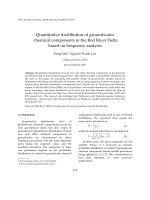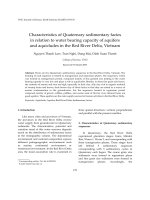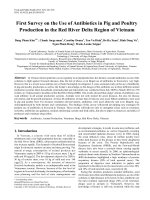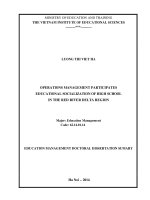Testing adaptability of introduced asparagus in the Red River Delta, 2016-2017
Bạn đang xem bản rút gọn của tài liệu. Xem và tải ngay bản đầy đủ của tài liệu tại đây (117.37 KB, 4 trang )
Journal of Vietnam Agricultural Science and Technology - No.1(3)/2018
TESTING ADAPTABILITY OF INTRODUCED ASPARAGUS
IN THE RED RIVER DELTA, 2016 - 2017
Pham
i
u Huong*1
Abstract
Asparagus (Asparagus o cinalis L.) is a perennial crop which is productive for een years or more a er establishment.
As a valuable vegetable due to rich in anti-cancer and anti-oxidation compounds and high economic crop, Asparagus
production is continuously extended in Vietnam. Asparagus breeding and cultivation has not been paid attention
yet in Vietnam. Aims of the research was evaluation of adaptability of three heat tolerance varieties introduced from
the Netherlands as Sunlim, K767 and K1867 in the Red River Delta, Vietnam. e growth characteristics, potential
yield, brix of the roots, and pests and diseases were basically tested on the rst harvest. All the tested varieties were
susceptible to Phomopsis asparagi causing stem blight, a dangerous disease of Asparagus in the Red River Delta,
Vietnam. K767 performed well in the eld and had good yield: 78 - 90 kg/ha per day of Grade 1 during the rst and
the second harvest.
Keywords: Asparagus, K767, Phomopsis Asparagi, Sunlim, variety
INTRODUCTION
Asparagus is a member of the Liliaceae family and
has separate male and female plants. Asparagus is a
perennial crop which is productive for een years
or more a er establishment. It originated along the
sea coasts of Europe and Asia. Asparagus has been
cultivated for over 2000 years. In Vietnam, the rst
Asparagus crop was introduced in 1960. Until 2005
Asparagus was grown widely in Ninh uan , Binh
uan, Ba Ria Vung Tau, Dong Nai, Cu Chi, Binh
Phuoc, Vinh Long, An Giang (Hung, 2016). Recently,
Asparagus is planting in the North: Hai Duong,
Hanoi, Hai Phong, Bac Ninh, and Phu o.
Asparagus product is rich in anti-cancer and antioxidation compounds such as rutins, saponins,
polyphenols, polysaccharides and polyamines, is
considered a high value vegetable crop (Maeda
et al., 2005; Xiang et al., 2014, Jaramillo-Carmona
et al., 2017).
super male fathers. Without cherries formation, the
Netherlands varieties are expected to have high yield.
Asparagus is adaptable to temperate regions where
low temperature or drought give the crop a rest period.
e minimum temperature for germination is 10oC.
e optimum range for germination is 16oC to 30oC.
e optimum temperature for germination is 24oC.
Asparagus breeding program in
e Netherlands
has bred heat tolerance varieties, which target to
tropical countries, such as Vietnam. e purpose of
this research is evaluation of adaptability of three heat
tolerance varieties imported from e Netherlands.
MATERIALS AND METHODS
Materials
ree Asparagus varieties Sunlim F1, K1867 and
K767 were tested. e varieties are heat tolerant, from
Limgroup, e Netherlands.
Asparagus can bring high income to the growers. In
Ninh uan province, farmers earned income from
asparagus of 150 - 300 million VND per hectare per
year. e price was from 30,000 VND to 90,000 VND
per kg depend on the season.
is crop has been
considered as a high value crop (Hung, 2016).
Methods
In Vietnam, most of the seed is imported from the
USA and
e Netherlands.
e USA varieties are
both male and female crops, therefore, the plant
forms cherries and spears during it’s crop duration,
causes reducing the spear yield. In addition, the
farmers prefer to buy F2 seed with segregation
because it is lower cost. at may reduce yield and
health of plants. In contrast, asparagus F1 bred by
e Netherlands companies are male plants due to
- Field design and spacing: RCBD design, 3 treatments
of three varieties, 3 replications. Size of the plot was
20 ˟ 2 m, 2 beds per plot.
1
*
Field Crops Research Institute
Corresponding author: Pham
i
Sowing seeds
e seeds were sown at the depth of 1 cm.
seedlings at age of 3 months were transplanted.
e
Experimental design
The Asparagus was transplanted on Mar 26, 2016.
Seedlings were transplanted when having 3 ferns
per plants.
Fertilizers application from March 2016 to March
2017.
u Huong. Email:
79
Vietnam Academy of Agricultural Sciences (VAAS)
Table 1. Soil properties of the trial eld
Wood powder: 4 kg/m2; Organic manure: 20 ton/ha;
NPK: 130 N : 130 P2O5 : 130 K2O kg/ha; MgO : 5 kg/ha.
- Data collection:
Germination rate: Count all number of seedlings per
total holes in trays of each varieties a er 30 days of
sowing.
Criteria
6.42
pH-KCl
5.65
EC
µS/cm
67.00
+
meq/100 g
5.00
Mg
meq/100 g
3.80
%
1.65
Phosphate available
(Bray II)
mg P2O5/100 g
11.27
Potassium available
Mg K2O /100 g
15.81
Ca
Growth characteristics: plant height and number of
stems per plant. Measure 20 plants per replication.
OM
e spears belong to Grade 1 were 30 - 35 cm long.
Spears with length > 40 cm were classi ed as Grade 2.
Spears of Grade 2 were harvested in the beginning.
Latter, spears of Grade 1 were harvested only.
Root Brix of each variety were collected to evaluate
the adaptability of each variety. A sample of 2 - 3 roots
per replication per variety to measure brix.
- Data analysis:
Statistical analysis of di erences between the
varieties was performed by analysis of variance using
IRRISTAT 4.0.
Time, location, climate and soil of the experimental
site
e trial was implemented at the Field Crops Research
Institute, Hai Duong, Vietnam with the latitudes of
20o 53’ N, 106o17’ E, from 2016 to 2017.
Soil properties of the trial eld was check in February,
2016, before transplanting (Table 1).
Value
pH-H2O
Phomosis asparagi infection, based on numbers of
infected on 20 plants of each replication.
Yield of the rst harvest based on harvest of each
whole plot.
Unit
+
RESULTS AND DISCUSSION
Growth characteristics: Plant height and number
of stems per hill
Asparagus grew well in 2016. e growing of plant
height was about 10 - 15 cm per month. Nine months
a er transplanting, plant height reached 1.5 m to 1.6 m
(Table 2). K767 was 7 - 8 cm shorter than others. In
the tropical region, the short type is preferred due to
strong wind in summer season.
Number of stems at three months a er transplanting,
mean number of stems reached 12 - 14 stems per plant.
e plants reached about 28 - 36 stems per plants a er
two months, from June to August 2016. A er August
2016, mean number of stems was maintained at 32
- 48 per plant (Table 2) due to harvest Sep 5 - Oct 6
and stems heavily infected by Phomopsis Asparagi
were removed.
Table 2. Plant height and number of stems per plant measured every 2 months
Varieties
Mean plant height (cm)
Mean number of stems
10-Jun
10-Aug
11-Oct
14-Dec
10-Jun
10-Aug
11-Oct
14-Dec
SunlimF1
88
109
125
159
14
34
36
40
K1867
79
116
128
160
13
28
32
36
K767
77
109
111
152
12
36
45
48
Yield
e rst harvest in 2016 was from Sep 5 to Oct 6.
e harvested duration was prolonged 32 days. K767
provided the highest yield (Table 3). In 2017, all the
spears were cut in March 2017. Four to ve good
stems were kept per each plant. e other spears were
80
harvested. In both harvest times, yield of K767 was
higher than that of Sunlim F1 and K1867 (Table 3).
Yield of kg/ha/day a er cutting all the spears in
March - April 2017 was lower than in the rst harvest
(Table 3).
Journal of Vietnam Agricultural Science and Technology - No.1(3)/2018
Table 3. Comparison of the three varieties’ yield
2017 (March 24 - April 14)
(kg/ha/day)
2016 (Sep 5 - Oct 6) (kg/ha/day)
Grade 1
(30 - 35 cm)
Grade 2
(> 40 cm)
Total yield
Grade 1
(30 - 35 cm)
Sunlim F1
81.7a
3.3
85a
46.5a
K 1867
84.3a
2.5
86.8a
52.7a
K 767
90.0b
3.3
93.3b
77.9 b
Varieties
Note: Means with common letter are not signi cantly di erent at P ≤ 0.05.
Brix
Discussion
Brix of roots was measured and harvest was stopped
immediately due to the brix < 10% in K1867 and
K767. Brix of K1867 was critical low. Brix of K767 was
lower than Sunlim F1 may be because K767 provided
higher yield of shoots than Sunlim F1 did (Table 4).
Good adaptation varieties of Asparagus in sub
tropical/tropical condition are very important to
get good yield. However, Phomopsis asparagi is the
most constrain in Vietnam as well as many Asian and
Paci c countries where are growing Asparagus, such
as Japan, China, Myanmar, Australia, New Zealand
(L-H Cheah et al., 2006; Zaw et al., 2017). ere has
been no resistant bred variety yet, neither chemicals
controlling the diseases e ectively (Lu et al., 2008;
Sonoda, 1997; Zhang, 2018). Besides looking for good
adaptability varieties, integrated crop management is
needed to control the disease, such planting density,
nutrition management, increasing biodiversity of
micro-organisms in the soil.
Table 4. Comparison of Brix of the three
varieties a er the second harvest.
Varieties
Mean Brix (%)
Sunlim F1
10.7
K 1867
3.8
K 767
7.8
Pests and diseases
Spedotera litura attacked young ferns. is pests were
controlled easily by using biological pesticide BT
(Bacilus uringgiensis).
e most serious problems is Phomopsis asparagi.
In 2016 the disease increased by the time. In 2017,
due to high moisture, from June 8 to July 25, 2017,
it was rainy almost every day. All the ferns infected
by disease. e rate of ferns alive when the disease
infected in the end of June 2017 reached 38 - 46%
(Table 5). e di erence on rate of alive ferns when
Phomopsis asparagi infected among the three varieties
was not approved (P value > 0.05).
Table 5. Rate of alive ferns when
Phomopsis asparagi infected
Rate of alive ferns (%) (n = 60)
Varieties
10-Aug, 11-Oct, 14-Dec, 28-Jun,
2016
2016
2016
2017
CONCLUSIONS
Among three varieties tested, K767 had the shortest
plant height. In the tropical area short plant variety is
preferred. e variety also provided the highest yield
in the two harvests.
Although yield of Sumlim was lower than K767, brix
of its roots was higher than that of the other two
varieties a er 22 days of the second harvest, therefore,
it has good yield potential in the coming harvests.
K1867 was not a good option because the yield was
not signi cantly higher than Sunlim F1 but the brix
was critically low when checked a er the second
harvested.
e most serious problems on Asparagus grown in
lowland - Red River Delta of Vietnam is Phomopsis
asparagi infection. Asparagus can be grown in this
region only when diseases can be controlled.
Sunlim F1
98.6
86.1
66.5
41.7
REFERENCES
K 1867
99.7
89.8
78.1
45.8
K 767
98.9
91.5
70.3
37.7
Pvalue
> 0.05
> 0.05
> 0.05
> 0.05
Cheah L-H., Horlock C. M., Beasley D.R, 2006.
Integrated management of new asparagus diseases.
New Zealand Institute for Crop & Food Research
Ltd. Report.
81
Vietnam Academy of Agricultural Sciences (VAAS)
General Statistic O ce, 2018. Statistical year book of
Vietnam 2017. Statistical Publishing House, Hanoi.
General Statistic O ce, 2017. Statistical year book of
Vietnam 2016. Statistical Publishing House, Hanoi.
Hung P.T., 2016. Overview on green asparagus.
Department of Sciences and Technology, Ninh
uan province. Report.
Jaramillo-Carmona S., Rodriguez-Arcos R., JiménezAraujo A., López S, Gil J., Moreno R., GuillénBejarano R., 2017. Saponin pro le of wild asparagus
species. J Food Sci., 82: 638-646.
Lu G., Jian W., Zhang J., Zhou Y., Cao J., 2008.
Suppressive e ect of silicon nutritionon Phomopsis
stem blightdevelopment. HortScience, 43: 811-817.
Maeda T, Kakuta H, Sonoda T, Motoki S, Ueno
R, Suzuki T, Oosawa K., 2005. Anti-oxidation
capacities of extracts from green, purple, and
white asparagus spears related to polyphenol
concentration. HortScience, 40: 1221-1224.
Sonoda T., Uragami A., Kaji K., 1997. Evaluation
on Asparagus o cinalis cultivars for resistance to
stem blight by using a novel inoculation method.
HortScience, 32: 1085-1086.
Xiang J., Xiang Y., Lin S., Xin D., Liu X. ,Weng L.,
Zhang M., 2014. Anticancer e ects of deproteinized
asparagus polysaccharide on hepatocellular
carcinoma in vitro and in vivo. Tumor Biol., 35:
3517-3524.
Zaw M., Naing T.A.A., Matsumoto M., 2017. First
report of stem blight of asparagus caused by
Phomopsis Asparagi in Myanmar. New diseases
report. 35: 17.
Zhang Y., Qu H., Zhao P., Wu L., Zhou J. Tang Y. Lou
S., Chen G., 2018. Transformation of Phomopsis
asparagi with green uorescent protein using
protoplasts. Can. J. Plant Pathol., 4: 254-260.
Date received: 23/11/2018
Date reviewed: 2/12/2018
Reviewer: Dr. To i u Ha
Date approved for publication: 21/12/2018
ACTION MODES OF MALQ ISOLATED FROM Escherichia coli K12
Tran Phuong Lan*1, Nguyen Minh
uy2
Abstract
e gene of malQ encoding 4-α-glucanotransferase (amylomaltase) is located in the malPQ operon of Escherichia coli
K12. e reactions of the enzyme with several types of carbohydrate were carried out under the optimal conditions in
an e ort to understand the function of MalQ enzyme in maltodextrin and glycogen metabolism of E. coli. e enzyme
catalyzed the hydrolysis of the α-1,4 glucosidic linkage of linear maltodextrins, released the reducing-end glucose of
dextrins, and it also transferred glycosyl residues onto the non-reducing end of an acceptor via a disproportionation
reaction. e smallest substrate that MalQ recognized of this reaction mode was maltose. Glucose was not the substrate
but the great acceptor for this enzyme. e enzyme performed intramolecular transglycosylation to produce the cyclic
form having degree of polymerization (DP) from DP20 to DP33 with DP24 as the main product in the reaction with
amylose substrate. ese data may explain the understanding of MalQ mechanism in vivo.
Keywords: MalQ, 4-α-glucanotransferase (amylomaltase), Escherichia coli, cycloamylose, transglycosylation
INTRODUCTION
MalQ, known as 4-α-glucanotransferase or
amylomaltase, is a member of the α-amylase family
and is widely distributed in plants and microorganisms
where it is involved in starch metabolism (Sato et al.,
2013; Critchley et al., 2001) or maltooligosaccharide
metabolism (Boos and Shuman, 1998). MalQ was rst
reported as disproportionating enzyme (D-enzyme)
in potato tubers by Peat et al. (1956) and was
reported to occur in a wide range of plant tissues
by Lin and Preiss (1988). Early studies focusing on
the biochemical properties of D-enzymes illustrated
that the multiple D-enzymes have common reaction
characteristics. MalQ appears to have different
physiological functions in microorganisms. This
enzyme was rst described by Monod and Torriani
(1948) as a maltose-inducible enzyme. Since then,
its gene has been cloned into several bacteria, and
homologous genes have been identi ed in several other
bacterial genomes. According to Kaper et al. (2005)
the enzyme catalyzes the transfer of the α-1,4-glucan
segment from one α-1,4-glucan molecule (donor)
to another α-1,4-glucan molecule (acceptor), as
expressed in the following equation:
Faculty of Agriculture and Natural Resourses, An Giang University
College of Agriculture and Applied Biology, Can o University
*
Corresponding author: Tran Phuong Lan. E-mail: /
1
2
82









